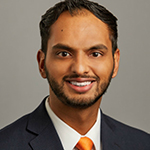Prioritizing development of AI in workflow is biggest challenge for IT shops in 2018

The most common uses for artificial intelligence in healthcare today are for search, classification and reasoning, in that order.
"AI is able to ingest massive amounts of data using technology such as text analytics and Natural Language Processing," said Ajay Royyuru, vice president, healthcare and life sciences research, at IBM Watson Health. "With that, AI systems are able to detect patterns and similarities within that data that may unlock new insights for clinicians and scientists. A system that can reason not only can identify, but make recommendations or suggestions based on its trained parameters."
Moving into 2018, healthcare professionals working on AI face many challenges. Experts in the field currently working on AI projects at their organizations point to a couple that will require the brainpower of human beings to overcome.
Future-proofing AI
How AI is driving forward-looking healthcare orgs.
Elizabeth Clements, business architect, enterprise architecture, at Geisinger Health, which is working on some machine learning programs, said a major challenge facing hospitals and health systems working on AI in 2018 will be prioritizing machine learning program development while faced with multiple competing IT priorities that require their attention.
"It is often difficult for our IT and analytics departments to find bandwidth to be able to develop these more cutting-edge solutions beyond research and development," she said.
Overcoming the problem may not be easy, but she contended that there are ways to get past this issue.
"It is often difficult for our IT and analytics departments to find bandwidth to be able to develop these more cutting-edge solutions beyond research and development."
Elizabeth Clements, Geisinger Health
"The beauty of machine learning is that its utility can speak for itself through even the smallest, most remedial use-case using open source applications," she said. "If a small team can show success, future funding and prioritization may be available. These teams just need to determine a basic approach to get things started."
Vibin Roy, MD, is medical director at the Parkland Center for Clinical Innovation. The Parkland Center developed, validated and implemented an automated, real-time, AI-powered early warning system model for predicting risk of unplanned intensive care unit transfers or cardiopulmonary arrests outside the ICU. The automated model outperforms non-automated models and unaided clinician observation, leading to improved care and patient safety.
Roy said that going forward into 2018, exponential growth in medical knowledge and data being collected for patient care will continue to make it increasingly challenging for caregivers to provide optimal care.
"For example, much of the EHR data is not well organized or is not quickly interpretable – time spent on documenting or trying to understand the EHR data can take away from direct patient care and also lead to provider burnout," he said.
"AI and machine learning have tremendous potential to provide real-time and pertinent information that can enhance the quality of care being provided and can also reduce cognitive overload for care team members."
"It will also be incumbent upon health systems to work with medical schools to make sure the next generation of providers are well equipped to interpret and apply AI and machine learning insights in their daily patient care."
Vibin Roy, MD, Parkland Center for Clinical Innovation
Compared with many other industries, however, healthcare still is in a relatively early stage of using AI and integrating it into its current workflows and EHRs. Creating a seamless, integrated and transparent process around predictions is key to increasing adoption rates, Roy said.
"Despite all the hype, AI will not replace physicians, but physicians with AI will eventually replace physicians without AI, and healthcare systems with AI will eventually replace healthcare systems without AI," he said.
"It will also be incumbent upon health systems to work with medical schools and higher education institutions to make sure the next generation of providers are well equipped to interpret and apply AI and machine learning insights in their daily patient care," he added.
Roy said healthcare organizations have their work cut out for them in 2018 when it comes to what they can be doing to pave the way for more and better AI in the industry.
"Hospital and health system CIOs should focus efforts on ensuring that their system has the IT and resource support needed to provide customized and intelligent use/collection of EHR data," he said. "Focus on areas and tools that will make staff workflow more efficient and directly help staff practice evidence-based and optimal care without adding to their work."
Twitter: @SiwickiHealthIT
Email the writer: bill.siwicki@himssmedia.com


























